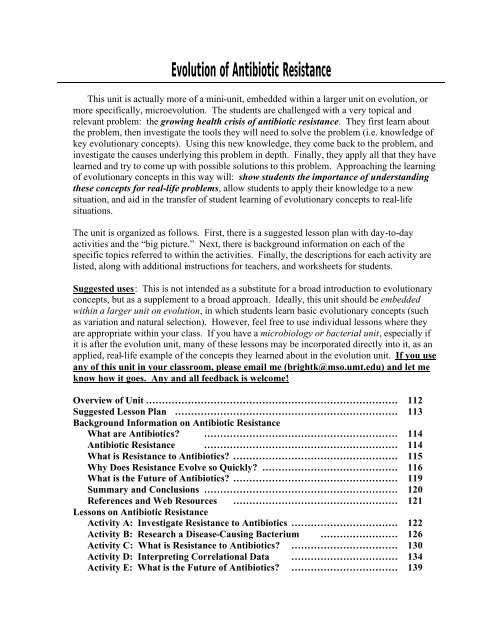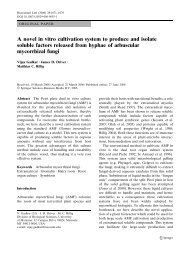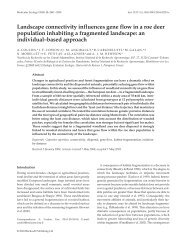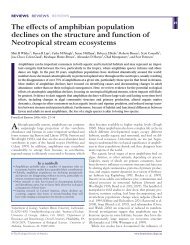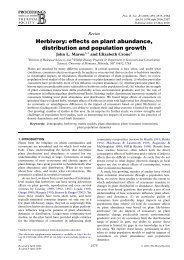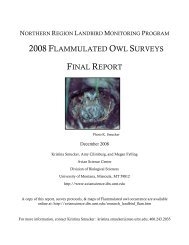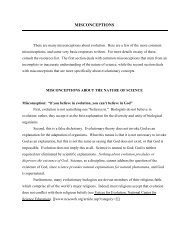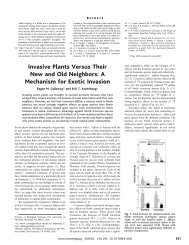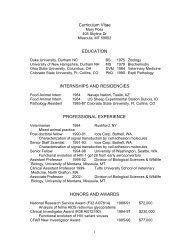Evolution of Antibiotic Resistance-Printable Format - Teach ...
Evolution of Antibiotic Resistance-Printable Format - Teach ...
Evolution of Antibiotic Resistance-Printable Format - Teach ...
Create successful ePaper yourself
Turn your PDF publications into a flip-book with our unique Google optimized e-Paper software.
<strong>Evolution</strong> <strong>of</strong> <strong>Antibiotic</strong> <strong>Resistance</strong><br />
This unit is actually more <strong>of</strong> a mini-unit, embedded within a larger unit on evolution, or<br />
more specifically, microevolution. The students are challenged with a very topical and<br />
relevant problem: the growing health crisis <strong>of</strong> antibiotic resistance. They first learn about<br />
the problem, then investigate the tools they will need to solve the problem (i.e. knowledge <strong>of</strong><br />
key evolutionary concepts). Using this new knowledge, they come back to the problem, and<br />
investigate the causes underlying this problem in depth. Finally, they apply all that they have<br />
learned and try to come up with possible solutions to this problem. Approaching the learning<br />
<strong>of</strong> evolutionary concepts in this way will: show students the importance <strong>of</strong> understanding<br />
these concepts for real-life problems, allow students to apply their knowledge to a new<br />
situation, and aid in the transfer <strong>of</strong> student learning <strong>of</strong> evolutionary concepts to real-life<br />
situations.<br />
The unit is organized as follows. First, there is a suggested lesson plan with day-to-day<br />
activities and the “big picture.” Next, there is background information on each <strong>of</strong> the<br />
specific topics referred to within the activities. Finally, the descriptions for each activity are<br />
listed, along with additional instructions for teachers, and worksheets for students.<br />
Suggested uses: This is not intended as a substitute for a broad introduction to evolutionary<br />
concepts, but as a supplement to a broad approach. Ideally, this unit should be embedded<br />
within a larger unit on evolution, in which students learn basic evolutionary concepts (such<br />
as variation and natural selection). However, feel free to use individual lessons where they<br />
are appropriate within your class. If you have a microbiology or bacterial unit, especially if<br />
it is after the evolution unit, many <strong>of</strong> these lessons may be incorporated directly into it, as an<br />
applied, real-life example <strong>of</strong> the concepts they learned about in the evolution unit. If you use<br />
any <strong>of</strong> this unit in your classroom, please email me (brightk@mso.umt.edu) and let me<br />
know how it goes. Any and all feedback is welcome!<br />
Overview <strong>of</strong> Unit …………………………………………………………………… 112<br />
Suggested Lesson Plan …………………………………………………………… 113<br />
Background Information on <strong>Antibiotic</strong> <strong>Resistance</strong><br />
What are <strong>Antibiotic</strong>s? …………………………………………………… 114<br />
<strong>Antibiotic</strong> <strong>Resistance</strong> …………………………………………………… 114<br />
What is <strong>Resistance</strong> to <strong>Antibiotic</strong>s? …………………………………………… 115<br />
Why Does <strong>Resistance</strong> Evolve so Quickly? …………………………………… 116<br />
What is the Future <strong>of</strong> <strong>Antibiotic</strong>s? …………………………………………… 119<br />
Summary and Conclusions …………………………………………………… 120<br />
References and Web Resources …………………………………………… 121<br />
Lessons on <strong>Antibiotic</strong> <strong>Resistance</strong><br />
Activity A: Investigate <strong>Resistance</strong> to <strong>Antibiotic</strong>s …………………………… 122<br />
Activity B: Research a Disease-Causing Bacterium …………………… 126<br />
Activity C: What is <strong>Resistance</strong> to <strong>Antibiotic</strong>s? …………………………… 130<br />
Activity D: Interpreting Correlational Data …………………………… 134<br />
Activity E: What is the Future <strong>of</strong> <strong>Antibiotic</strong>s? …………………………… 139
Suggested Lesson Plan for Unit<br />
Part I. Define the Problem to be Investigated: Bacterial <strong>Resistance</strong> to<br />
<strong>Antibiotic</strong>s<br />
Activity A) Investigate <strong>Resistance</strong> to <strong>Antibiotic</strong>s<br />
Day 1: Have students set up experiment on resistance.<br />
Day 2: Have students examine their experiment and make observations; small<br />
group/full class discussion <strong>of</strong> the significance <strong>of</strong> their findings.<br />
Activity B) Research a Disease-Causing Bacterium<br />
Day 3: Assign research project, and help students begin researching their bacteria.<br />
Part II. Lessons on <strong>Evolution</strong>ary Concepts<br />
Introduce students to broad evolutionary concepts (variation, mutation, natural selection,<br />
adaptation, speciation, macroevolution, etc.).<br />
Part III. Investigate Reason for Problem 1: Bacteria Evolve!<br />
Activity C) What Is <strong>Resistance</strong> To <strong>Antibiotic</strong>s?<br />
Day 4: Have students get together in small groups and discuss questions from<br />
worksheet; end with a full class wrap-up on what exactly is resistance to antibiotics<br />
(an evolutionary response by bacteria).<br />
Part IV. Investigate Reason for Problem 2: <strong>Antibiotic</strong>s Select for <strong>Resistance</strong>,<br />
and Human Behavior Provides Opportunities for Bacteria to Evolve<br />
Activity D) Interpreting Correlational Data<br />
Day 5: Have students break into small groups and work through worksheet; group<br />
discussion/lecture on how using antibiotics exerts natural selection for resistance.<br />
Part V. Solutions to the <strong>Antibiotic</strong>s Problem<br />
Activity E) What is the Future <strong>of</strong> <strong>Antibiotic</strong>s?<br />
Day 5: At the end <strong>of</strong> class, assign articles to read for the next day.<br />
Day 6: Have students break into small groups to discuss their articles, using the<br />
questions in the worksheet as a guide; full-class discussion <strong>of</strong> possible solutions.
Background Information on <strong>Antibiotic</strong> <strong>Resistance</strong> for<br />
<strong>Teach</strong>ers<br />
What are <strong>Antibiotic</strong>s?<br />
In the late 1920’s, the Scottish microbiologist Alexander Fleming returned from a trip<br />
to find that one <strong>of</strong> his petri dishes containing the bacterium, Staphylococcus aureus, was<br />
contaminated with the mold, Penicillium notatum. Like a good scientist, he did not just<br />
throw it out and start over; rather, he made an observation: there were no bacterial staph<br />
colonies growing directly around the mold. There was a zone that was free <strong>of</strong> bacterial<br />
growth directly surrounding the mold. Upon closer inspection, he noticed that the mold was<br />
secreting a liquid (now called penicillin) that he later learned was the cause <strong>of</strong> death to the<br />
bacteria growing in close proximity to the mold.<br />
What Fleming had discovered (actually, re-discovered) was an antibiotic: a chemical<br />
that inhibits the growth <strong>of</strong> or kills microorganisms (e.g. bacteria). <strong>Antibiotic</strong>s have evolved<br />
in fungi and bacteria as defenses against other microbes. Microorganisms <strong>of</strong>ten compete<br />
with each other for the same resources. In response to competition, many fungal and<br />
bacterial species have evolved chemical weapons to inhibit other species. <strong>Antibiotic</strong>s are the<br />
chemical weapons <strong>of</strong> fungi and bacteria.<br />
What do antibiotics do? How do they kill bacteria? They work through several<br />
different means. Some inhibit the synthesis (or production) <strong>of</strong> bacterial cell walls; some<br />
inhibit the synthesis <strong>of</strong> proteins; still others inhibit the replication <strong>of</strong> bacterial DNA. All <strong>of</strong><br />
these are, <strong>of</strong> course, detrimental to the bacteria that encounter the antibiotic. So detrimental,<br />
in fact, it <strong>of</strong>ten kills them.<br />
We humans know a good thing when we see it. A chemical substance that kills<br />
bacteria: we could use this to our advantage! And did we ever. Within a few decades, both<br />
naturally occurring and synthetic antibiotics were produced in mass quantities and given to<br />
people who were sick with infectious diseases. And they worked. <strong>Antibiotic</strong>s were the<br />
miracle cure to all kinds <strong>of</strong> infectious diseases that had been plaguing humans for<br />
hundreds <strong>of</strong> years. <strong>Antibiotic</strong>s worked so well, in fact, that in 1969, the U.S. Surgeon<br />
General declared: “it is time to close the book on infectious disease.” The war against<br />
bacteria was over, and we had won!<br />
Or had we?<br />
<strong>Antibiotic</strong> 1 <strong>Resistance</strong><br />
In 1941, all strains <strong>of</strong> staphylococcal bacteria (common causes <strong>of</strong> wound and<br />
postoperative infection) were susceptible to (killed by) penicillin. Three years later, one<br />
1 A more general term is antimicrobials; this includes antibiotics as well as drugs that are used to treat diseases<br />
caused by microbes other than bacteria (e.g. malaria, HIV/AIDS). Although antibiotics are exclusively discussed<br />
here, the evolutionary principles described are similar for all pathogenic microbes, not just bacteria.
strain <strong>of</strong> staph was no longer susceptible to penicillin; it was resistant to (not killed by)<br />
penicillin. Today, especially in hospitals, there are strains <strong>of</strong> staph bacteria that are resistant<br />
to, not just one, but nearly all known antibiotics. Although most <strong>of</strong> the multiple-drug<br />
resistant staph strains are only found in hospitals, recently, four children in North Dakota and<br />
Minnesota were killed by staph infections that they had acquired outside <strong>of</strong> a hospital.<br />
Staphylococcus is not the only problem bacterium. More than two-dozen types <strong>of</strong><br />
bacteria are now resistant to one or more types <strong>of</strong> antibiotics that had previously been<br />
effective against them. Certain strains <strong>of</strong> three bacterial species (Enterococcus,<br />
Pseudomonas, and Mycobacterium tuberculosis) are resistant to every antibiotic, including<br />
vancomycin, the antibiotic previously known as “the drug <strong>of</strong> last resort.” Multi-drug<br />
resistant tuberculosis (TB, caused by Mycobacterium tuberculosis) is nearly epidemic in<br />
some areas <strong>of</strong> the world (e.g. Russia) 2 .<br />
<strong>Antibiotic</strong>s are not as effective at killing bacteria as when they were first introduced.<br />
People are dying from infections that were easily treated just a few years ago. It has been<br />
estimated that infections caused by resistant bacteria kill as many as 77,000 people every<br />
year in the United States alone. <strong>Resistance</strong> to antibiotics costs dollars as well as lives: it<br />
costs the nation up to $30 billion every year.<br />
What happened? Why can we no longer cure infections that were very easily treated<br />
just a few years ago?<br />
What is <strong>Resistance</strong> to <strong>Antibiotic</strong>s?<br />
There are several ways to address this question. First <strong>of</strong> all, there is a prevalent<br />
misconception that antibiotics no longer work because the people who take the drugs have<br />
developed a tolerance for the drug. This is not the case. Humans do not develop a tolerance<br />
for antibiotics. <strong>Antibiotic</strong>s work by inhibiting or killing the bacteria living inside <strong>of</strong> us. The<br />
reason they no longer work (i.e. we do not get better after taking the antibiotic) is that the<br />
bacteria are no longer inhibited/killed by the drug—they are resistant to the effects <strong>of</strong> the<br />
antibiotic.<br />
So, back to our question, what is resistance to antibiotics? Let us first address this<br />
question physiologically. There are several ways that bacteria resist the effects <strong>of</strong> antibiotics.<br />
Some resistant bacteria inactivate the antibiotic by destroying or modifying the drug itself so<br />
that it is no longer toxic. Some resistant bacteria pump the drug out <strong>of</strong> the bacterial cell so<br />
that the concentration <strong>of</strong> the drug is too low to be effective. Still, other resistant species have<br />
an altered form <strong>of</strong> the target site <strong>of</strong> the drug (the place on the cell where the drug binds), so<br />
the antibiotic cannot “find” its target. These are examples <strong>of</strong> the types <strong>of</strong> resistance<br />
characters that bacteria use to fight antibiotics.<br />
Now, let us address this question on a different level: evolutionarily. What has<br />
happened to make these bacteria resistant to antibiotics? Have individual bacteria developed<br />
2 For other examples <strong>of</strong> the growing problem <strong>of</strong> antbiotic resistance, see NIH fact sheet (www.<br />
niaid.nih.gov/factsheets/antimicro.htm)
a tolerance to the drug? Have they physiologically acclimated to the presence <strong>of</strong> the<br />
antibiotic so that it no longer affects them? No. What has happened is bacterial evolution.<br />
Mutations that allow the bacteria to resist the effects <strong>of</strong> the antibiotic occur and have a<br />
selective advantage. These mutations have the type <strong>of</strong> effects that were described in the<br />
previous paragraph (for example, there is a mutation that results in an altered form <strong>of</strong> the<br />
target site). These resistance characters are <strong>of</strong>ten simple mutations (i.e. changes in a single<br />
gene). The result is that resistant bacteria differ genetically from their susceptible<br />
ancestors.<br />
So what happens if a bacterial cell has a mutation that allows it to resist the effect <strong>of</strong> an<br />
antibiotic? If that bacterium is in the presence <strong>of</strong> the antibiotic, then it will have an<br />
advantage: the drug will not kill it! It will be able to reproduce, while the susceptible<br />
bacteria (which are inhibited or killed by the antibiotic) will not. In the presence <strong>of</strong> the<br />
antibiotic, the resistant mutant has a selective (reproductive) advantage over normal cells 3 .<br />
Originally, most or all bacteria in the population were susceptible to the antibiotic 4 . Over<br />
many generations, the resistant type will make up a greater and greater percentage <strong>of</strong> the<br />
population. Eventually, most or all <strong>of</strong> the individuals in the bacterial population will be<br />
resistant to the antibiotic. The population has evolved resistance due to natural selection by<br />
antibiotics: the genetic structure <strong>of</strong> the population has changed, from susceptible to the<br />
antibiotic to resistant to the antibiotic.<br />
Why Does <strong>Resistance</strong> Evolve so Quickly?<br />
Bacterial populations can evolve resistance very quickly. For example, in one<br />
hospital, initially 5% <strong>of</strong> the strains <strong>of</strong> staphylococcal bacteria were resistant to the antibiotic<br />
cipr<strong>of</strong>loxacin. Within one year, 80% <strong>of</strong> the bacterial strains were resistant. From 5% to 80%<br />
in one year! Why do bacterial populations evolve resistance so quickly? There are two basic<br />
reasons:<br />
1) in general, bacteria have the capacity to evolve quickly<br />
2) humans are helping them to evolve even faster<br />
Bacteria Biology<br />
There are several aspects <strong>of</strong> bacteria biology that contribute to their capacity for rapid<br />
evolution. Bacteria, relative to humans, have very short generation times. A generation<br />
3 Note: when these mutations occur in the absence <strong>of</strong> the antibiotic, the resistant form does not have a selective<br />
advantage, and evolution <strong>of</strong> resistance does not occur. Typically, these resistance characters are evolutionarily<br />
costly to the bacteria that have them (e.g. they must divert energy from reproduction to maintaining the<br />
resistance character), so when these mutations occur in the absence <strong>of</strong> the antibiotic, they are selected against.<br />
4 There may also be a very small percentage <strong>of</strong> the original population that is naturally resistant to the antibiotic.<br />
Naturally resistant bacteria are partially resistant—they are not be killed by a low dosage <strong>of</strong> the antibiotic, but<br />
will be killed by a higher dosage. This is analogous to humans and the flu—not everyone gets the flu, even if<br />
they are exposed to it (some people are naturally resistant). Naturally resistant bacteria were present long<br />
before the first antibiotics were used in humans (a legacy <strong>of</strong> the age-old arms race between competing<br />
microorganisms). Since the heavy use <strong>of</strong> antibiotics in humans, they have become much more common, and<br />
mutations that strengthen this partial resistance have been selected for.
time is the time it takes to go from one generation to the next. For example, in humans, it<br />
takes on average about 20 years to go from the birth <strong>of</strong> a child to the birth <strong>of</strong> that child’s<br />
child. Therefore, the generation time for humans is approximately 20 years. Contrast this<br />
with the average bacterial generation time <strong>of</strong> hours or even minutes! Under favorable<br />
conditions, a single bacterial cell will very quickly reproduce into a colony containing many<br />
generations <strong>of</strong> its <strong>of</strong>fspring and their <strong>of</strong>fspring. These colonies can have so many individual<br />
cells that, within hours or days, it will be large enough to see with the naked eye. Organisms<br />
with fast generation times, like bacteria, have the capacity for very rapid adaptation to a<br />
changing environment. Since evolutionary change occurs across generations, organisms<br />
with fast generation times (like bacteria) can evolve much faster than organisms with slow<br />
generation times (like humans). Some bacteria species can go through thousands <strong>of</strong><br />
generations in a single year.<br />
Bacterial populations are also very high in numbers and are quite genetically<br />
variable. Mutations are the primary source <strong>of</strong> genetic variation. Mutations (accidents in<br />
DNA replication) are rare events. In bacteria, a mutation at a particular gene occurs on<br />
average once in about every 10,000,000 cell divisions. Since bacteria are so numerous and<br />
divide so <strong>of</strong>ten, even these rare events actually occur quite <strong>of</strong>ten. As an example, E. coli<br />
cells in a human colon divide 2 x 10 10 times every day. That means that every day in an E.<br />
coli population, approximately 2000 cells will have a mutation at a particular gene 5 . So, even<br />
though mutations are rare events, they occur <strong>of</strong>ten enough in bacterial populations to create a<br />
lot <strong>of</strong> genetic variation within populations.<br />
Mutation is not the only way that a bacterium can acquire a resistance gene. Bacteria<br />
have three other methods <strong>of</strong> acquiring genes that sexual organisms (like us) do not have.<br />
Bacteria can pick up pieces <strong>of</strong> DNA (containing genes) from their environment<br />
(transformation), they can obtain a gene from another bacterium (conjugation), and genes<br />
can also be transferred to a bacterium by a virus (transduction). So, even if a resistance gene<br />
does not occur through mutation, it can be acquired through one <strong>of</strong> these methods.<br />
To summarize, bacterial populations evolve resistance to antibiotics so quickly<br />
because <strong>of</strong> their fast generation times, large population sizes, and unique methods <strong>of</strong> gene<br />
acquisition. These are some <strong>of</strong> the reasons that bacteria have been so evolutionarily<br />
successful.<br />
Human Behavior<br />
The second reason that bacterial populations evolve resistance to antibiotics so quickly<br />
is that several aspects <strong>of</strong> human behavior actually contribute to their capacity to evolve<br />
rapidly. Understandably, when antibiotics first became available, people started to use them.<br />
A lot. Today, antibiotics are overused, and unfortunately antibiotics are <strong>of</strong>ten misused.<br />
5 If the probability <strong>of</strong> a mutation at a particular gene is 1 x 10 -7 , and there are 2 x 10 10 cell divisions, then the average<br />
number <strong>of</strong> cell divisions that will result in a mutation at this gene is: (1 x 10 -7 ) * (2 x 10 10 ) = 2000.
Overuse:<br />
? It has been estimated that nearly half <strong>of</strong> all medical prescriptions for antibiotics in the<br />
U.S. are unnecessary. Many doctors prescribe antibiotics under pressure from their<br />
patients, even if the antibiotic is not warranted (e.g. for a viral infection). Direct-toconsumer<br />
marketing by pharmaceutical companies can also lead to inappropriate<br />
demand for antibiotics by patients.<br />
? Almost half <strong>of</strong> all antibiotics produced in North America and Europe are given to<br />
livestock; most are given not to fight infection, but prophylactically to promote<br />
growth in healthy animals. There is growing evidence that this use <strong>of</strong> antibiotics in<br />
livestock leads to resistance in human bacteria.<br />
? It is currently trendy to include antibacterial agents in common household cleaning<br />
products (even hand lotion!). It is becoming more and more difficult to find cleaners<br />
without antibacterial agents.<br />
Misuse:<br />
? Medical doctors, including veterinarians and dentists, <strong>of</strong>ten incorrectly prescribe<br />
antibiotics: they prescribe the wrong antibiotics or the incorrect dosage <strong>of</strong> an<br />
antibiotic for a particular infection; they prescribe antibiotics for non-bacterial<br />
infections (e.g. colds, coughs, or influenza); they prescribe antibiotics<br />
prophylactically (in a low dosage for months at a time to prevent future infections; for<br />
example, for young children with a history <strong>of</strong> multiple ear infections).<br />
? Many doctors also prescribe broad-spectrum antibiotics, which kill many different<br />
types <strong>of</strong> bacteria, rather than run a diagnostic lab test so they can prescribe a narrowspectrum<br />
antibiotic that would specifically target the bacteria causing the infection.<br />
? In many other countries, antibiotics are freely available over the counter, without a<br />
doctor’s prescription, leading to widespread misuse.<br />
? Patients themselves also contribute to the problem when they feel better after a few<br />
days, and then stop taking the antibiotics, instead <strong>of</strong> continuing with the full cycle<br />
prescribed to them. In a 1995 Gallup poll, it was estimated that more than half <strong>of</strong><br />
American adults taking antibiotics failed to complete their prescribed dosage.<br />
Compounding all <strong>of</strong> these problems, the pharmaceutical industry (until very recently)<br />
had all but stopped research and development <strong>of</strong> new antibiotics.<br />
Bacteria Biology + Current Human Behavior = Fast <strong>Evolution</strong><br />
How have these two factors helped speed up the evolution <strong>of</strong> resistance? In essence,<br />
we are exerting extremely strong selection pressures on these bacteria by our heavy use <strong>of</strong><br />
antibiotics. Bacteria are continuously exposed to antibiotics, and this has created very strong<br />
selection on these populations to evolve resistance. The more exposure to antibiotics that<br />
bacterial populations have, the greater the selection pressure on these populations to evolve
esistance. The rate that evolutionary change occurs depends directly upon the strength <strong>of</strong><br />
natural selection imposed. Strong selection leads to rapid evolution.<br />
<strong>Antibiotic</strong>s do not just kill the bacteria species that we want them to act on (i.e. the<br />
bacteria causing the infection we are trying to get rid <strong>of</strong>). <strong>Antibiotic</strong>s also affect a lot <strong>of</strong><br />
bacteria that are beneficial to us, or that are commensal with us (neither harmful nor<br />
beneficial). This decreases the population sizes <strong>of</strong> these other bacteria, which reduces the<br />
competition for the harmful bacteria that survive. This lack <strong>of</strong> competition for resources<br />
allows the surviving resistant bacteria to do very well.<br />
In addition, by using antibiotics incorrectly, we are giving the bacterial populations<br />
the opportunity to adapt quickly. For example, if you take an antibiotic correctly—in an<br />
adequately high dosage and for the entire cycle—most <strong>of</strong> the bacteria in your system will be<br />
killed. By greatly reducing the population size <strong>of</strong> the bacteria, you greatly decrease the<br />
chance that any one bacterium will mutate to a resistant form. However, if you incorrectly<br />
take the antibiotic—if you stop taking it after a few days or if the dosage is not high<br />
enough—more <strong>of</strong> the bacteria will survive 6 . Higher numbers <strong>of</strong> bacteria means a greater<br />
chance that a resistance mutation will occur in any one <strong>of</strong> the bacterial cells. When these<br />
mutations do occur, they rapidly increase in the population, due to the very strong selection<br />
pressure exerted by the presence <strong>of</strong> the antibiotic.<br />
In conclusion, the combination <strong>of</strong> several aspects <strong>of</strong> bacterial biology (fast generation<br />
time, high population sizes) and human behavior (heavy use <strong>of</strong> antibiotics, misuse <strong>of</strong><br />
antibiotics) has led to an ever-increasing problem <strong>of</strong> bacteria resistant to our only means <strong>of</strong><br />
controlling them.<br />
What is the Future <strong>of</strong> <strong>Antibiotic</strong>s?<br />
Can we stop the evolution <strong>of</strong> resistance? Because <strong>of</strong> their quick generation times and<br />
high numbers, bacteria have a very high capacity to quickly adapt to changing environments.<br />
We cannot change the biology <strong>of</strong> the bacteria. As long as we expose bacteria to antibiotics,<br />
they will evolve resistance to them. However, we can slow down the evolution <strong>of</strong> resistance<br />
by modifying human behavior.<br />
What can be done to slow down the evolution <strong>of</strong> resistance?<br />
First, decrease the selection pressure on bacterial populations by decreasing the<br />
overall use <strong>of</strong> antibiotics. Researchers are recommending prudent use <strong>of</strong> antibiotics (see<br />
website <strong>of</strong> the Alliance for the Prudent Use <strong>of</strong> <strong>Antibiotic</strong>s). Doctors and patients need to be<br />
educated about when and how to use antibiotics appropriately. <strong>Antibiotic</strong>s should not be<br />
prescribed for viral infections, such as the common cold. For minor bacterial infections, a<br />
period <strong>of</strong> “watchful waiting” for a day or two to see if the infection will clear on its own has<br />
also been recommended.<br />
6 Also, any naturally resistant bacteria will survive if the antibiotic is not taken correctly (see footnote 4).
Scientists are also recommending that the agricultural industry discontinue the use <strong>of</strong><br />
antibiotics in livestock and on crops, especially those antibiotics that are used to treat disease<br />
in humans (see website <strong>of</strong> the Union <strong>of</strong> Concerned Scientists).<br />
Second, stop giving bacteria extra opportunities for mutations (i.e. use antibiotics<br />
appropriately). When an antibiotic is necessary, the most appropriate antibiotic should be<br />
prescribed based on the results <strong>of</strong> laboratory tests to confirm the precise bacterium causing<br />
the infection. Often, a doctor will prescribe an antibiotic without conducting a laboratory test<br />
to determine the bacterial species causing the infection. If the antibiotic is not appropriate,<br />
and the patient does not get better, he/she then comes back for a different prescription. In<br />
this case, all <strong>of</strong> the bacteria in the patient were unnecessarily exposed to an inappropriate<br />
antibiotic. When possible, narrow-spectrum antibiotics should be used, rather than a broadspectrum<br />
antibiotic, which affects many different types <strong>of</strong> bacteria.<br />
<strong>Antibiotic</strong>s need to be taken in strong enough dosages to kill all the bacteria causing the<br />
infection, and they need to be taken responsibly: each dose should be taken on time, and all<br />
doses (i.e. the full cycle) should be taken. Doctors and pharmacists should be educated about<br />
responsible usage, and they should actively encourage their patients to take antibiotics<br />
responsibly—exactly as prescribed, and for the entire course. Patients should not demand<br />
antibiotics from their doctors.<br />
Third, reduce the spread <strong>of</strong> resistant bacteria from one person to another. This can<br />
be done with the same techniques used for controlling the spread <strong>of</strong> diseases themselves—<br />
better hygiene, clean water, vigorous hand washing, etc. The agricultural industry can also<br />
help to stop the spread <strong>of</strong> resistant bacteria by not using the same antibiotics in animals that<br />
are also used in humans (to avoid, for example, transferring resistant bacteria to humans in<br />
the food that we eat).<br />
Finally, more research is needed. Research on the optimal use <strong>of</strong> antibiotics will be<br />
necessary. It is still unclear exactly how to decrease the selection pressure on bacterial<br />
populations. The above suggestions can only help, but more research about how bacterial<br />
populations respond to antibiotics is still needed. Also needed is basic research on microbial<br />
biology: physiology, genetics, ecology, and evolution. Understanding basic biological<br />
processes in these organisms will help to develop new drugs and treatment protocols.<br />
Most “new” antibiotics these days are modified from older ones. Because these drugs<br />
are so similar to older varieties, resistance evolves very quickly. Research and development<br />
<strong>of</strong> completely new antibiotics will also become increasingly important. Pharmaceutical<br />
companies have started to respond to this need, but since it can take up to ten years for a new<br />
drug to be approved for use in the United States, there will be a lag time before new drugs<br />
will become available.<br />
Summary and Conclusions<br />
To summarize, antibiotics have been miracle drugs, curing all sorts <strong>of</strong> formerly<br />
incurable infectious diseases. Unfortunately, humans have used these drugs unwisely,
allowing the bacteria to quickly evolve ways to get around them. If we had been aware <strong>of</strong><br />
the principles <strong>of</strong> evolutionary biology, if we had understood that the heavy use <strong>of</strong> antibiotics<br />
applies enormous selection pressure on bacterial populations to evolve resistance, and that<br />
incorrect usage <strong>of</strong> antibiotics gives the bacterial populations the opportunity to quickly<br />
evolve resistance, then we may not have found ourselves in the situation that we are today.<br />
Granted, even if antibiotics had been used wisely from the very beginning, bacterial<br />
populations would still have evolved resistance eventually; however, it would have taken<br />
much longer, we would have known it would happen, and would have been better prepared<br />
to manage the evolution <strong>of</strong> resistance. Unfortunately, because we ignored evolution for so<br />
long, we are in a crisis <strong>of</strong> antibiotic resistance.<br />
References Used:<br />
Campbell, N.A., J.B. Reece, & L.G. Mitchell. 1999. Biology (5 th ed.). Benjamin/Cummings, California.<br />
Daniel, H.J. III 1999. Otitis media: an evolutionary perspective, in W.R. Trevathan, E.O. Smith, & J.J.<br />
Mckenna (eds.) <strong>Evolution</strong>ary Medicine. Oxford University Press, New York.<br />
Ewald, P.W. 1994. <strong>Evolution</strong> <strong>of</strong> Infectious Disease. Oxford University Press, Oxford.<br />
Falkow, S. & D. Kennedy. 2001. <strong>Antibiotic</strong>s, Animals, and People—Again! Science 291: 397.<br />
Levin, B.R. & R.M. Anderson. 1999. The population biology <strong>of</strong> anti-infective chemotherapy and the evolution<br />
<strong>of</strong> drug resistance: more questions than answers, in S.C. Stearns (ed.) <strong>Evolution</strong> in Health & Disease.<br />
Oxford University Press, Oxford.<br />
Nesse, R.M. & G.C. Williams. 1994. Why We Get Sick: The New Science <strong>of</strong> Darwinian Medicine. Vintage<br />
Books, New York.<br />
Neu, H.C. 1992. The crisis in antibiotic resistance. Science 257: 1064-1073.<br />
Nissinen, A., P. Grönroos, P. Huovinen, E. Herva, M. Katila, T. Klaukka, S. Kontiainen, O. Liimatainen, S.<br />
Oinonen, & P.H. Mäkelä. 1995. Development <strong>of</strong> ?-lactamase-mediated resistance to penicillin in<br />
middle-ear isolates <strong>of</strong> Moraxella catarrhalis in Finnish children, 1978-1993. Clincal Infectious Diseases<br />
21: 1193-6.<br />
Palumbi, S.R. 2001. The <strong>Evolution</strong> Explosion: How Humans Cause Rapid <strong>Evolution</strong>ary Change. W.W.<br />
Norton & Company, New York.<br />
Radetsky, P. 1998. Last days <strong>of</strong> the wonder drugs. Discover, November, 1998.<br />
Rose, M.R. 1998. Darwin’s Spectre: <strong>Evolution</strong>ary Biology in the Modern World. Princeton University Press,<br />
New Jersey.<br />
Seppälä, H., T. Klaukka, J. Vuopio-Varkila, A. Muotiala, H. Helenius, K. Lager, P. Huovinen, and the Finnish<br />
Study Group for Antimicrobial <strong>Resistance</strong>. 1997. The effect <strong>of</strong> changes in the consumption <strong>of</strong><br />
macrolide antibiotics on erythomycin resistance in group A streptococci in Finland. New England<br />
Journal <strong>of</strong> Medicine 337: 441 – 446.<br />
Williams, R.J. & D.L. Heymann. 1998. Containment <strong>of</strong> antibiotic resistance. Science 279: 1153-115.<br />
Web resources on antibiotic resistance:<br />
Alliance for the Prudent Use <strong>of</strong> <strong>Antibiotic</strong>s: www.healthsci.tufts.edu/apua/index.html<br />
Centers for Disease Control and Prevention: www.cdc.gov/drugresistance/index.htm and<br />
www.cdc.gov/ncidod/emergplan/antiresist/page_3.htm<br />
National Institutes <strong>of</strong> Health: www.niaid.nih.gov/factsheets/antimicro.htm<br />
Union <strong>of</strong> Concerned Scientists: www.ucsusa.org/index.html<br />
U.S. Food and Drug Administration: www.fda.gov/oc/opacom/hottopics/anti_resist.html<br />
World Health Organization: www.who.int/emc/amr.html
Part I: Define the Problem<br />
Activity A) Investigate <strong>Resistance</strong> to <strong>Antibiotic</strong>s—<strong>Teach</strong>er’s Guide<br />
Overview: Begin the evolution unit with a real problem: bacterial resistance to antibiotics.<br />
Learning Objectives: Students will understand what antibiotics are and what they do (i.e.<br />
they are chemicals that kill bacteria, which humans have co-opted and use to fight<br />
bacterial infections); students will understand that antibiotics do not kill all <strong>of</strong> the<br />
bacteria they are used against.<br />
Class Time: 2 – 3 days<br />
Day 1: Have students set up experiment on resistance.<br />
Day 2: Have students examine their experiment and make observations; small<br />
group/full class discussion <strong>of</strong> the significance <strong>of</strong> their findings.<br />
Background Information: “What are <strong>Antibiotic</strong>s?” and “<strong>Antibiotic</strong> <strong>Resistance</strong>”<br />
Materials: petri dishes filled with nutrient agar (one or two for each student)<br />
sterile cotton swabs<br />
distilled water (or tap water, if distilled water is unavailable)<br />
antibiotic disks (several kinds, one disk <strong>of</strong> each per student)<br />
control disks (one per student)<br />
markers<br />
scotch tape (to seal the lid <strong>of</strong> the petri dish to the bottom, for transport)<br />
copies <strong>of</strong> worksheet (one for each student)<br />
In this exercise, students will be introduced to simple methods used in microbiology.<br />
Students collect bacteria from the classroom or themselves, and test these bacteria against<br />
several antibiotics. They will see “first-hand” the effects that antibiotics have on bacteria, as<br />
well as the ability <strong>of</strong> some bacteria to resist antibiotics. This will lead into a<br />
lecture/discussion on antibiotics, resistance to antibiotics, and the increasingly serious public<br />
health crisis.<br />
Materials can be obtained from a biological supply catalog. Blank control disks and<br />
antibiotic disks are typically sold in packs <strong>of</strong> 50. I would suggest you use several different<br />
types <strong>of</strong> antibiotics that have been very commonly used; including both antibiotics that work<br />
on gram positive bacteria and antibiotics that work on gram negative bacteria; for example,<br />
erythromycin, penicillin, streptomycin, and tetracycline. Tetracycline has been used a lot for<br />
skin infections (e.g. acne), so this would be a particularly good one to use if you have<br />
students swab the oily parts <strong>of</strong> their faces. If you do not have microbiology materials inhouse,<br />
you can also obtain petri dishes prepared with nutrient agar from these sources.<br />
Encourage students to collect bacteria from a variety <strong>of</strong> sources (each student choosing<br />
one source only). Sink drains, or other moist places work well, as do places with a lot <strong>of</strong><br />
dust. They could even swab themselves (e.g. the oily skin around their nose or forehead).<br />
How long it takes for visible growth <strong>of</strong> the colonies will depend on the environmental<br />
conditions where they are stored. Ideally, place the petri dishes in an incubator set at 37 o C,
ut if that is not available, set them on a warm shelf, away from direct sunlight. If you do not<br />
have an incubator and your room is not particularly warm, you might do the first part on a<br />
Friday, and the second part the following Monday.<br />
Points for Discussion:<br />
? Be sure to discuss why they are using a control (blank) disk.<br />
? Ask students why they think some bacteria can grow closer to the antibiotic disks<br />
than other bacteria can.<br />
? Review the importance <strong>of</strong> mutation as a source <strong>of</strong> variation.<br />
? Review ecological concepts (population growth, etc.) so that students understand<br />
what they are seeing.
Investigate <strong>Resistance</strong> to <strong>Antibiotic</strong>s—Student Worksheet<br />
In this laboratory investigation, you will investigate the effect <strong>of</strong> antibiotics on bacteria.<br />
Part I: Collect and culture bacteria.<br />
Materials:<br />
petri dish with nutrient agar<br />
sterile cotton swab<br />
distilled water<br />
one control disk<br />
antibiotic disks (one <strong>of</strong> each type)<br />
marker<br />
scotch tape<br />
Instructions:<br />
1) Collect bacteria:<br />
? choose a location to collect bacteria<br />
? wet a sterile cotton swab with distilled water (or tap water, if distilled water is not<br />
available)<br />
? thoroughly rub the swab around your chosen place<br />
Record the location you collected your sample: _____________________<br />
2) Spread collected bacteria over the medium:<br />
? rub the cotton swab back and forth across the agar (covering the entire plate)<br />
? rotate the plate 90 o (1/4 turn), and rub the swab back and forth across the entire<br />
plate<br />
? rotate the plate another 90 o (in the same direction), and repeat.<br />
3) Place the disks on medium<br />
? *carefully place a control disk (a “blank” disk with no antibiotic) onto the<br />
medium and press it gently into the medium (Why do you place the control disks<br />
first, before the treated disks?)<br />
? carefully place each <strong>of</strong> your antibiotic disks onto the medium, gently pressing<br />
them into the medium<br />
*note: be sure to evenly space the disks across the medium, none <strong>of</strong> them too<br />
close to the edge (see figure)<br />
*note: as you place each disk, be sure to label the bottom <strong>of</strong> the petri dish (i.e.<br />
the side with the nutrient agar) with the name <strong>of</strong> the antibiotic at that spot<br />
4) Incubate the dish<br />
? close the lid on the petri dish<br />
? use scotch tape to seal the lid <strong>of</strong> the petri dish to the bottom<br />
? store the dish agar side (bottom) up in an incubator
Part II: Make observations.<br />
Check on your culture daily, and make observations, using the following questions to<br />
guide you. You may use a dissecting microscope, if available. Describe what you see in<br />
words and make detailed drawings. You do not have to be an “artist” to make scientific<br />
drawings; these are descriptive drawings, and are used everyday by scientists to make<br />
detailed observations.<br />
1) Describe and draw any bacterial or fungal colonies you see. How many different types<br />
are there? What color are they? What kind <strong>of</strong> texture do they have (smooth, shiny, dull,<br />
wet, dry, waxy, etc.)? How big are they? What shape are they? Are they raised or flat<br />
against the surface <strong>of</strong> the agar?<br />
2) Draw and describe any “zones <strong>of</strong> inhibition” surrounding the disks (an area without<br />
bacterial growth). Which disks have zones around them? How big is each zone? Are<br />
there different zones for different types <strong>of</strong> bacteria? Or for different types <strong>of</strong> antibiotics?<br />
Are there any bacterial colonies growing within a zone?
Activity B) Research a Disease-Causing Bacterium—<strong>Teach</strong>er’s Guide<br />
Overview: Continue the investigation <strong>of</strong> the problem: bacterial resistance to antibiotics.<br />
Learning Objectives: Students will understand that resistance to antibiotics is a growing,<br />
very serious, public health problem.<br />
Class Time: 1 day<br />
Day 3: Assign research project, and help students begin researching their species.<br />
Background Information: “What are <strong>Antibiotic</strong>s?” and “<strong>Antibiotic</strong> <strong>Resistance</strong>”<br />
In this assignment, students will investigate the problem <strong>of</strong> antibiotic resistance on their<br />
own. They are assigned one species <strong>of</strong> bacteria to research: what disease(s) it causes, what<br />
antibiotic(s) have been used against it, and whether or not those antibiotic(s) are still<br />
effective. This is a very flexible assignment. It could be done as a group project or an<br />
individual assignment. It could be a written assignment and/or a short oral presentation<br />
(depending upon how much class time you have, and how it fits in your class). The<br />
worksheet “Research a Disease—Student Instructions” is just one suggestion for how to<br />
assign this project.<br />
Be sure to help students with how to conduct research. For example, give them reputable<br />
websites (see list below) and aid them in computer searches for articles. Tell them the<br />
difference between peer-reviewed, primary literature (journal articles), secondary literature<br />
(books and reviews <strong>of</strong> the primary literature), and websites (for the most part, non-peer<br />
reviewed, and should be taken with a grain <strong>of</strong> salt, unless it is maintained by a reputable<br />
organization). Also instruct students on how to cite references, both in-text, and at the end <strong>of</strong><br />
the paper in a “literature cited” section (see “A Brief Guide to the Literature”).<br />
Suggested bacterial species:<br />
Mycobacterium tuberculosis<br />
Staphylococcus aureus<br />
Enterococcus faecalis<br />
Pseudomonas aeruginosa<br />
Streptococcus pneumoniae<br />
Escherichia coli<br />
Streptococcus faecalis<br />
Web resources on antibiotic resistance:<br />
Alliance for the Prudent Use <strong>of</strong> <strong>Antibiotic</strong>s: www.healthsci.tufts.edu/apua/index.html<br />
Centers for Disease Control and Prevention: www.cdc.gov/drugresistance/index.htm and<br />
www.cdc.gov/ncidod/emergplan/antiresist/page_3.htm<br />
National Institutes <strong>of</strong> Health: www.niaid.nih.gov/factsheets/antimicro.htm<br />
Union <strong>of</strong> Concerned Scientists: www.ucsusa.org/index.html<br />
U.S. Food and Drug Administration: www.fda.gov/oc/opacom/hottopics/anti_resist.html<br />
World Health Organization: www.who.int/emc/amr.html
A Brief Guide to the Literature<br />
Primary literature includes peer-reviewed articles in scholarly journals, such as<br />
Nature, Bioscience, Science, etc. Secondary sources are books or edited volumes that use<br />
the primary literature (e.g. textbooks).<br />
When you use an idea that you obtained from one <strong>of</strong> your sources, cite this source in<br />
the text, using the last name <strong>of</strong> the author(s) and the publication year in parentheses. For<br />
example:<br />
… (Chen 1994)…<br />
If you use the author(s) name(s) as part <strong>of</strong> your sentence, then just include the<br />
publication year in parentheses:<br />
Rudolph and Stewart (1998) …<br />
For citations with more than two authors, just list the first author’s name and et al.<br />
…(Morris et al. 1997)…<br />
At the end <strong>of</strong> the paper, include a Literature Cited section, with the full reference <strong>of</strong><br />
each <strong>of</strong> the sources you cite within your text (in alphabetical order by author). The following<br />
are examples <strong>of</strong> full citations from a book, and a journal article:<br />
Nesse, R.M. & G.C. Williams. 1994. Why We Get Sick: The<br />
New Science <strong>of</strong> Darwinian Medicine. Vintage Books, New<br />
York.<br />
Neu, H.C. 1992. The crisis in antibiotic resistance. Science 257:<br />
1064-1073.<br />
Websites are generally not peer-reviewed and thus are not primary or even secondary<br />
literature. When citing websites, just give the address <strong>of</strong> the site within the text (in<br />
parantheses). If you need to include websites in the literature cited (in most cases, you will<br />
not need to), give a very brief description <strong>of</strong> the site, as well as the address. For example:<br />
Centers for Disease Control and Prevention<br />
http://www.cdc.gov
Research a Disease—Student Instructions<br />
For this assignment, you will conduct library research on a specific bacterium that causes<br />
a disease in humans, and prepare a two-paged, typed report. Specifically, you will<br />
investigate the history <strong>of</strong> the disease caused by your bacterium, and speculate on its future.<br />
Use the following questions to guide you (but do not just list the answers in your report!):<br />
What kind <strong>of</strong> disease does this bacterial species cause? What would your chance <strong>of</strong> survival<br />
have been if you caught this disease 100 years ago? 30 years ago? Today? 10 years from<br />
now? Be sure to explain why you think this. What antibiotics have been used on this<br />
disease? Are they all still effective? Will they be effective 10 years from now? Explain why<br />
you think this.<br />
Be sure to cite all references you used.
Part II. <strong>Evolution</strong>ary Concepts<br />
Overview: Introduce students to broad evolutionary concepts (variation, mutation, natural<br />
selection, adaptation, speciation, macroevolution, etc.).<br />
Learning Objectives: Students will understand basic evolutionary concepts; students will<br />
obtain the tools needed to fully understand the antibiotic problem.<br />
Class Time: 1 – 2 weeks
Part III. Investigate Reason for Problem 1<br />
Activity C) What is <strong>Resistance</strong> to <strong>Antibiotic</strong>s?—<strong>Teach</strong>er’s Guide<br />
Overview: After students are familiar with key evolutionary concepts, make the connection<br />
between these concepts and resistance to antibiotics.<br />
Learning Objectives: 1) Students will understand that bacterial populations evolve resistance<br />
to antibiotics. 2) Students will understand that mutations for resistance that occur in<br />
the presence <strong>of</strong> an antibiotic will have a selective advantage, leave more <strong>of</strong>fspring, and<br />
thus increase in number in the population. 3) Students will understand that scientific<br />
claims are based on carefully collected evidence.<br />
Class Time: 1 day<br />
Day 4: Have students get together in small groups and discuss questions from<br />
worksheet; end with a full class wrap-up on what exactly is resistance to antibiotics (an<br />
evolutionary response by bacteria).<br />
Background Information: “ What is <strong>Resistance</strong> to <strong>Antibiotic</strong>s?”<br />
In this exercise, students are challenged to apply the evolutionary concepts they have<br />
learned to the practical problem they are faced with: antibiotic resistance. The objective is<br />
to understand what bacterial resistance is (evolution <strong>of</strong> bacterial populations) and what it is<br />
not (the development <strong>of</strong> tolerance by individual bacteria or people).<br />
Have students work in pairs or small groups (<strong>of</strong> 3 – 4). Armed with their research on<br />
antibiotics and disease (Part I) and their new knowledge about evolutionary concepts (Part<br />
II), have them work through the worksheet together. Use the points for discussion with<br />
individual groups, or as a full-class wrap-up to assess student understanding <strong>of</strong> the key<br />
concepts.<br />
Answers to student questions:<br />
Question 2: These data rule out hypothesis A, since they provide evidence that the bacteria<br />
have changed (the person has not changed).<br />
Question 3: These data support hypothesis C, but do not rule out hypothesis B, since more<br />
and more <strong>of</strong> the population could be developing a tolerance for the drug.<br />
Question 4: These data support hypothesis C, and rule out hypothesis B, since there is<br />
evidence <strong>of</strong> a genetic difference between the susceptible and resistant bacteria. The<br />
population has clearly evolved: most likely, a mutation occurred in a gene affecting the<br />
target site <strong>of</strong> the antibiotic, and since the population was in the presence <strong>of</strong> the antibiotic, this<br />
mutant was selected for and increased in the population.<br />
Points for discussion:<br />
? make sure students understand that a mutation occurred, and since it was advantageous<br />
in the presence <strong>of</strong> the antibiotic (it was not killed by the antibiotic), it had a reproductive<br />
advantage, and thus increased in the population.
? be sure that students are aware <strong>of</strong> the difference between develop (a non-genetic change<br />
that occurs within an individual) and evolve (a genetic change that occurs within a<br />
population <strong>of</strong> individuals across generations). These two terms are very different<br />
biologically, but are <strong>of</strong>ten used interchangeably, especially in the popular press (e.g.<br />
“bacteria develop resistance”).
What is <strong>Resistance</strong> to <strong>Antibiotic</strong>s?—Student Worksheet<br />
In this task, you are challenged to understand exactly what is going on in a bacterial<br />
population that is now resistant to an antibiotic to which it had previously been susceptible.<br />
Work through the following questions.<br />
1) You are infected with a bacterial disease. Your sister had this same illness last week, and<br />
took a full cycle <strong>of</strong> antibiotics. She quickly became better. You started taking the same<br />
antibiotic, but they had no effect. In fact, you had to return to the doctor after a week,<br />
because you did not feel better. What has happened? Why did you remain sick after<br />
taking antibiotics, while your sister quickly recovered? There are three possible<br />
hypotheses:<br />
A) you developed a tolerance for the antibiotic (i.e. you experienced a non-genetic<br />
change that made you less sensitive to the effects <strong>of</strong> the antibiotic).<br />
B) the bacteria infecting you developed a tolerance for the antibiotic (i.e. individual<br />
bacteria experienced a non-genetic change that made them less sensitive to the<br />
effects <strong>of</strong> the antibiotic).<br />
C) the bacteria infecting you evolved to be resistant to the antibiotic (i.e. a genetic<br />
mutation for resistance occurred in a bacterial cell, it had a reproductive<br />
advantage and increased in the population).<br />
a) Which hypothesis (A, B, or C) do you think is most likely? _________________<br />
b) Explain why you chose this one.<br />
2) When you first visited your doctor, she told you that she is conducting research on<br />
antibiotics, and asked you to be a part <strong>of</strong> the study. You agree. As part <strong>of</strong> the study, you<br />
go to the doctor every day and let her take a new sample from your infection, which she<br />
then conducts tests on. She discovered that on the first day, your bacteria were<br />
susceptible to the antibiotic (i.e. the bacteria were killed by the antibiotic). She then<br />
prescribed the antibiotic to you, which you immediately began taking. Later in the week,<br />
the bacteria from your infection were found to be resistant to the antibiotic (i.e. the<br />
bacteria were not killed by the antibiotic).<br />
a) This result rules out which <strong>of</strong> the three hypotheses (A, B, or C)? ______________<br />
b) Why does this result rule out this particular hypothesis?
3) Another result from the study is that initially, all the bacteria were susceptible to the<br />
antibiotic, but by the third day, some <strong>of</strong> the bacteria were resistant to the antibiotic. With<br />
each passing day, more <strong>of</strong> the bacteria were resistant, until finally all <strong>of</strong> the bacteria were<br />
resistant.<br />
a) Does this result support either (or both) <strong>of</strong> the remaining hypotheses? ________<br />
b) Does it allow you to rule out either <strong>of</strong> them? ______________<br />
c) Explain your answers to a) and b).<br />
4) Your doctor performs a DNA analysis <strong>of</strong> the bacteria causing your infection, and<br />
discovers that the resistant bacteria differ from the susceptible bacteria by one gene: the<br />
gene that encodes the protein on the bacterial cell that is the “target” <strong>of</strong> the antibiotic (the<br />
target site is the place in the bacterial cell where the antibiotic binds and does its dirty<br />
work). The resistant bacteria have an altered form <strong>of</strong> this target site, with the result that<br />
the antibiotic is unable to bind to the target site, and thus is unable kill the bacterium.<br />
a) How did the resistant bacteria come to be different genetically from their susceptible<br />
ancestors?<br />
b) Which hypothesis does this result support? _______________<br />
c) Why does this result support this particular hypothesis?<br />
5) Given all <strong>of</strong> the above evidence, which hypothesis (A, B, or C) do you think is most<br />
likely correct? Explain.
Part IV. Investigate Reason for Problem 2<br />
Activity D) Interpreting Correlational Data—<strong>Teach</strong>er’s Guide<br />
Overview: Students will continue to investigate the reasons behind the growing crisis in<br />
antibiotic resistance, focusing more on how human behavior is aiding the evolution <strong>of</strong><br />
antibiotic resistance.<br />
Learning Objectives: Students will understand that the use <strong>of</strong> antibiotics exerts selection<br />
pressure on bacterial populations<br />
Class Time: 1 day<br />
Day 5: Have students break into small groups and work through worksheet; group<br />
discussion/lecture on how using antibiotics exerts natural selection for resistance.<br />
Background Information: “Why does <strong>Resistance</strong> Evolve so Quickly?”<br />
The goal <strong>of</strong> this lesson is to get students to think about the use <strong>of</strong> antibiotics as the actual<br />
cause <strong>of</strong> the evolution <strong>of</strong> resistance. Use <strong>of</strong> antibiotics creates selection pressure on the<br />
bacterial populations exposed to the antibiotics, thus leading to the evolution <strong>of</strong> resistance.<br />
In the exercise, students examine real data on the amount <strong>of</strong> antibiotics used in one<br />
community over time, and the prevalence <strong>of</strong> resistance to the antibiotic over the same time<br />
period. The amount <strong>of</strong> antibiotics used is positively correlated with the level <strong>of</strong> resistance<br />
over this time period. You can also use these data to show the gradual evolution from no<br />
resistance to increasingly more and more resistance.<br />
The data were taken from a community in Finland from 1978 – 1993. The researchers<br />
collected data on the annual amount <strong>of</strong> ? -lactam (penicillin, ampicillin, and related)<br />
antibiotics used in this community. They also collected samples <strong>of</strong> the bacterial species<br />
Moraxella catarrhalisis from young children with middle ear infections. They then<br />
examined the bacterial strains to see if they were susceptible or resistant to these antibiotics.<br />
The data given are a standardized measure <strong>of</strong> the volume <strong>of</strong> antibiotic usage (calculated as<br />
average daily dose), and the percentage <strong>of</strong> the bacterial strains that were found to be resistant<br />
to the antibiotic (between 0 – 100%). Data were taken from Nissenen et al. (1995) and Levin<br />
& Anderson (1999). The data from question 4 are also real (Seppälä et al. 1997); use <strong>of</strong> the<br />
antibiotic erythromycin was greatly limited in a Finnish community, with the result that the<br />
percentage <strong>of</strong> group A streptococci resistant to it was cut in half.<br />
Suggested Uses:<br />
Have the students graph the raw data, or give them copies <strong>of</strong> the following sample<br />
graphs. Have them make two graphs (antibiotic usage vs. year and percent resistant strains<br />
vs. year) and/or have them plot a correlation: percent resistant strains vs. antibiotic usage<br />
(with each point on the graph being the data for both for the same year). This will show them<br />
a positive correlation between these two variables.
Points for Discussion:<br />
? Of course, correlation does not equal causation, and this is important to point out to<br />
your students. But, correlative data such as these, along with other evidence (e.g.<br />
resistant bacteria are able to survive and thrive in the presence <strong>of</strong> antibiotics) allows<br />
us to conclude that the use <strong>of</strong> antibiotics are selecting for the evolution <strong>of</strong> resistance<br />
to them. Use question 3 to get this point across. The data in question 4 provides<br />
further evidence that antibiotic usage selects for resistance: when the antibiotic use is<br />
limited, selection for resistance decreases, thus leading to the evolution <strong>of</strong> decreased<br />
resistance.<br />
Literature Cited:<br />
Levin, B.R. & R.M. Anderson. 1999. The population biology <strong>of</strong> anti-infective chemotherapy and the<br />
evolution <strong>of</strong> drug resistance: more questions than answers, in S.C. Stearns (ed.) <strong>Evolution</strong> in<br />
Health & Disease. Oxford University Press, Oxford.<br />
Nissinen, A., P. Grönroos, P. Huovinen, E. Herva, M. Katila, T. Klaukka, S. Kontiainen, O.<br />
Liimatainen, S. Oinonen, & P.H. Mäkelä. 1995. Development <strong>of</strong> ?-lactamase-mediated<br />
resistance to penicillin in middle-ear isolates <strong>of</strong> Moraxella catarrhalis in Finnish children, 1978-<br />
1993. Clincal Infectious Diseases 21: 1193-6.
<strong>Antibiotic</strong> Usage<br />
% Resistant Strains<br />
0.95<br />
0.9<br />
0.85<br />
0.8<br />
1<br />
1.35<br />
1.3<br />
1.25<br />
1.2<br />
1.15<br />
1.1<br />
1.05<br />
100<br />
90<br />
80<br />
70<br />
60<br />
50<br />
40<br />
30<br />
20<br />
10<br />
0<br />
1978<br />
1978<br />
1979<br />
1979<br />
Annual <strong>Antibiotic</strong> Usage<br />
1980<br />
1981<br />
1982<br />
1983<br />
1984<br />
1985<br />
1986<br />
Year<br />
1987<br />
1988<br />
1989<br />
Percentage <strong>of</strong> Resistant Strains<br />
1980<br />
1981<br />
1982<br />
1983<br />
1984<br />
1985<br />
1986<br />
Year<br />
1987<br />
1988<br />
1989<br />
1990<br />
1990<br />
1991<br />
1991<br />
1992<br />
1992<br />
1993<br />
1993
Interpreting Data—Student Worksheet<br />
In this exercise, you will interpret real data on antibiotic resistance. These data were<br />
collected from a community in Finland from 1978 – 1993. The researchers collected data on<br />
the annual amount <strong>of</strong> antibiotics used in this community. They also collected samples <strong>of</strong><br />
bacteria from young children with middle ear infections. They then examined the bacterial<br />
strains to see if they were susceptible to (killed by) or resistant to (not killed by) these<br />
antibiotics. The data given below are a measure <strong>of</strong> the amount <strong>of</strong> antibiotics used each year,<br />
and the percentage <strong>of</strong> the bacterial strains that were found to be resistant to the antibiotic<br />
(between 0 – 100%).<br />
Annual Percent<br />
Year <strong>Antibiotic</strong> Resistant<br />
Usage Strains<br />
1978 0.84 0<br />
1979 0.92 2<br />
1980 1.04 29<br />
1981 0.98 46<br />
1982 1.02 45<br />
1983 1.03 58<br />
1984 0.95 61<br />
1985 1.12 60<br />
1986 1.06 49<br />
1987 1.14 59<br />
1988 1.21 58<br />
1989 1.28 71<br />
1990 1.32 84<br />
1991 1.31 79<br />
1992 1.27 78<br />
1993 1.28 91<br />
Instructions:<br />
Graph these data in two different graphs: A) antibiotic usage vs. year (antibiotic usage on<br />
the y-axis, year on the x-axis) and B) percent resistant strains vs. year (percent resistant<br />
strains on the y-axis, year on the x-axis). Using this information, answer the following<br />
questions:<br />
1) Overall, what happened to the annual antibiotic usage in this community over the period<br />
<strong>of</strong> the study (did it increase, decrease, or stay the same)?<br />
____________________
2) Overall, did the percentage <strong>of</strong> bacterial strains resistant to these antibiotics increase,<br />
decrease, or stay the same over this same time period?<br />
_______________________<br />
3) a) From these data, do you think these two factors (antibiotic usage and percentage <strong>of</strong><br />
strains resistant to the antibiotics) are related? _______________<br />
b) Do you think one <strong>of</strong> these factors was the cause <strong>of</strong> the other factor? _____________<br />
c) If you do, which one? _________________<br />
d) How might you be able to tell for sure?<br />
4) In another study, also in Finland, researchers investigated the effect <strong>of</strong> greatly limiting<br />
the use <strong>of</strong> an antibiotic on a community (kids still got ear infections, but they now used a<br />
“wait and see” approach to see if the infection would clear up on its own). After<br />
antibiotic usage was greatly decreased, the percentage <strong>of</strong> bacterial strains that were<br />
resistant to this antibiotic was decreased by 50% (cut in half). What does this new<br />
information tell you?
Part V. Solutions to the <strong>Antibiotic</strong> Problem<br />
Activity E) What is the Future <strong>of</strong> <strong>Antibiotic</strong>s?—<strong>Teach</strong>er’s Guide<br />
Overview: Students will apply their new knowledge <strong>of</strong> evolutionary concepts, as well as<br />
their knowledge <strong>of</strong> the antibiotics problem and its causes to discuss possible solutions.<br />
Learning Objectives: Students will understand that understanding evolution and evolutionary<br />
concepts is critical to identifying possible solutions to this growing health problem.<br />
Class Time: 1 day<br />
(Day 5: At the end <strong>of</strong> class, assign articles and worksheet.)<br />
Day 6: Have students break into small groups to discuss their articles, using the<br />
questions in the worksheet as a guide; full-class discussion <strong>of</strong> possible solutions.<br />
Background Information: “What is the Future <strong>of</strong> <strong>Antibiotic</strong>s?”<br />
In this exercise, students will discuss potential solutions to the antibiotic problem. They<br />
will begin by reading an article (as a homework assignment), and come to class prepared to<br />
discuss the article (have the students fill out the worksheet as they are reading the assigned<br />
article). The overall learning objective is for students to understand that understanding<br />
evolution and evolutionary concepts is critical to identifying possible solutions to this<br />
growing health problem. The article is used as a jumping-<strong>of</strong>f point for discussion. The<br />
discussion should be student-oriented, with the teacher guiding the discussion towards higher<br />
thinking objectives (analysis and synthesis).<br />
There are several ways to approach this. You could have each student read the same<br />
article, or you could assign several articles, one to each student, in a jigsaw-type exercise. In<br />
this case, within each small group <strong>of</strong> 3-4 students, each student would be the “expert” on<br />
their article, summarizing the article for the other students. This method may be preferable,<br />
since no one article lists all possible solutions.<br />
As a spin-<strong>of</strong>f, you might ask students to think about how the recent anthrax scare, and<br />
consequent stockpiling <strong>of</strong> cipro by individuals may affect our ability to respond in the case <strong>of</strong><br />
an actual bioterrorism event. See the web site <strong>of</strong> the Alliance for the Prudent Use <strong>of</strong><br />
<strong>Antibiotic</strong>s (www.healthsci.tufts.edu/apua/index.html) for a discussion <strong>of</strong> this problem and<br />
related links.<br />
Suggestions for Articles:<br />
Braffman-Miller, J. Beware the rise <strong>of</strong> antibiotic-resistant microbes. USA Today Magazine.<br />
March 1997.<br />
[This article is a bit long, but has a good overview <strong>of</strong> the history <strong>of</strong> antibiotics, the<br />
problem <strong>of</strong> antibiotic resistance (including a “close to home” discussion <strong>of</strong> a TB<br />
outbreak in a California high school), the reasons for the problem (including an explicit<br />
discussion <strong>of</strong> evolution), and potential solutions (vaccines, limiting use in humans, new<br />
antibiotics.) This would be a good article if you feel your students need the overview]
Christensen, D. Keeping bugs from pumping drugs. Science News. Feb. 12, 2000.<br />
[This article details efflux pump inhibitors, which inhibit bacteria from pumping<br />
antibiotics out <strong>of</strong> their cells—one type <strong>of</strong> resistant mechanism. This drug may give<br />
new life to antibiotics that are now useless because <strong>of</strong> resistant bacteria. These drugs<br />
are also mentioned in Travis’ article.]<br />
Levy, S.B. The challenge <strong>of</strong> antibiotic resistance. Scientific American, March 1998.<br />
[This article is long, but written by a leading researcher in the field <strong>of</strong> the evolution <strong>of</strong><br />
antibiotic resistance (one <strong>of</strong> the researchers interviewed in Radetsky’s article). It<br />
discusses the problem <strong>of</strong> resistance, as well as a problem that is <strong>of</strong>ten overlooked: the<br />
affect <strong>of</strong> antibiotics on the benign bacteria that normally help keep pathogenic bacteria<br />
in check. It discusses ways to reverse resistance (i.e. solutions to the problem), and also<br />
includes a box on the potential effects <strong>of</strong> antibacterials in household products.]<br />
Nemecek, S. Beating bacteria: new ways to fend <strong>of</strong>f antibiotic-resistant pathogens.<br />
Scientific American. Feb.,1997.<br />
[This is a very short article that basically lists several novel methods researchers are<br />
using to combat resistant bacteria, including genomics, new natural resources, synthetic<br />
chemicals, and bispecific antibodies.]<br />
Radetsky, P. Last days <strong>of</strong> the wonder drugs. Discover. Nov. 1998.<br />
[This is a bit long, but a very good article. It explicitly deals with the problem <strong>of</strong><br />
antibiotic resistance, and a potential solution based on evolutionary biology (including<br />
interviews with two evolutionary biologists working on this problem). The solution<br />
discussed is prudent use, with the hope <strong>of</strong> reverting bacterial populations to<br />
susceptibility.]<br />
Travis, J. 1994. Reviving the antibiotic miracle? Science 264 (5157): 360.<br />
[Despite being in Science, this is actually a review article that discusses new research<br />
into fighting bacteria. It describes several novel approaches, including “disarming”<br />
bacteria, rather than killing them, and new drugs, such as chemicals that block the<br />
pumps that resistant bacteria use to remove antibiotics from cells.]<br />
Points <strong>of</strong> Discussion/Questions to Guide Discussion:<br />
? As long as we use antibiotics against bacteria, they will evolve resistance. The question<br />
is, how can we manage/slow down this process? Since human behavior (overuse and<br />
misuse <strong>of</strong> antibiotics by industry, doctors, patients) is speeding up the evolution <strong>of</strong><br />
resistance, how can we try to change human behavior to slow this evolutionary process<br />
down?<br />
? Be explicit about how understanding evolution is critical in identifying solutions<br />
(although implementing these solutions is a different question—see next point).<br />
? In addition to the medical/scientific aspects <strong>of</strong> this problem, you may also want to discuss<br />
political and economic aspects as well (e.g. what will decreasing the use <strong>of</strong> antibiotics in<br />
agriculture do to productivity? how do we implement programs to effect change in our<br />
country, as well as encourage it in other countries?)<br />
? Be sure to cover the following points:
o decrease natural selection on bacterial populations by decreasing the overall<br />
amount <strong>of</strong> antibiotics used (i.e. prudent use)<br />
o stop giving bacterial populations opportunities to evolve: take full cycle <strong>of</strong><br />
antibiotics, etc.<br />
o reduce the spread <strong>of</strong> bacteria that are already resistant<br />
o more research: basic research on microbial biology and development <strong>of</strong> new<br />
drugs
What is the Future <strong>of</strong> <strong>Antibiotic</strong>s?—Student Instructions<br />
Read your assigned article for homework. During the next class, we will be discussing<br />
potential solutions to the problem <strong>of</strong> antibiotic resistance. As you read your article, answer<br />
the following questions:<br />
1) While reading the article, identify and define any words that were unfamiliar to you.<br />
2) Summarize the three or four main points the author tries to make in the article.<br />
3) What does the author view as the problem(s) with antibiotics?<br />
4) What does the author suggest as solutions to these problems?<br />
5) Can you think <strong>of</strong> any other solutions?


